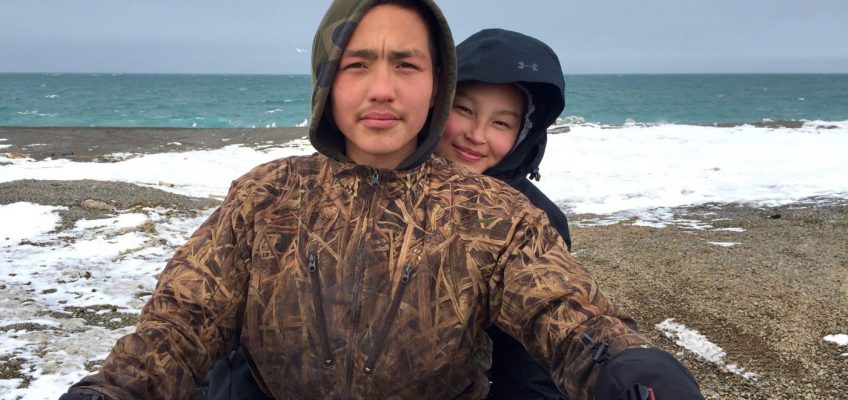In the remote Alaskan village of Gambell on St. Lawrence Island in the Bering Sea, students are allowed 10 excused absences a year for subsistence activities, primarily hunting. “If you don’t do subsistence activities, you die,” says the school principal in the documentary “One with the Whale,” airing this week on public television as part of Independent Lens.
Directed by Peter Chelkowski (whose credits include the NatGeo series “Life Below Zero: First Alaskans”) and environmental journalist Jim Wickens, the film is about many things at once: Climate change; poverty; parents worrying about their teenagers; trying to maintain traditions amid diminishing resources; and online bullying from activists when 16-year-old Chris Apassingok successfully hunts his first whale.
“One with the Whale” mainly follows the Apassingok family, but it also captures a broader context of life in Gambell, where the population is primarily Yup’ik Indigenous and numbers less than 700. Everything has to be flown in, which is expensive. When Mom goes shopping for groceries at the Gambell Native Store, she says they spend $300 to $500 a week on food. She holds up a box of Minute instant rice: $11.29. A six-pack of toilet paper is $13. Fresh produce is in short supply. As a result, more than 80% of their diet comes from subsistence hunting. A whale can feed the entire village for months.
Despite the prevalence of snow everywhere (there are no cars in sight, only four-wheelers and snowmobiles), out on the water Chris’s father is concerned about the lack of ice. “The walrus and the seal migrate with the ice. Without that ice, there’s no game and there’s no food.”
Review: Lily Gladstone and Riley Keough shine in Hulu’s dark true-crime drama ‘Under the Bridge’
‘The Jinx – Part Two’ review: A filmmaker continues his investigation into accused killer Robert Durst
What the ‘Fallout’ show gets right about the post-apocalyptic video game series
Michael Douglas has a knack for unforgettable roles — here are 7 of the best
‘Diarra from Detroit’ review: Defying categorization, this new BET+ series is sardonic and self-deprecating
We learn that internet service came to Gambell fairly recently, but nearly everyone on camera has a smartphone. In 2017, Chris caught his first whale and the photos were shared on Facebook. Locally, he was celebrated as a provider. But hundreds of thousands of hateful messages and death threats came pouring in from people outside the community, primarily followers of Paul Watson, who is known for the reality series “Whale Wars.” A teacher at Chris’s school is aghast: “Telling a 16-year-old from rural Alaska — where the suicide rates are higher than any other part the country — to go kill himself is insane.” The experience has a visible effect on Chris, who is sweet and goofy but becomes withdrawn and morose. He doesn’t want to talk about it with the filmmakers or his mother, and it’s unclear if he felt he could talk about his feelings with anyone. This is a consistent outcome with online bullying, with the additional subtext that this close-knit community, new to the downsides of social media, is at a loss as well. (The filmmakers focus specifically on the people of Gambell and do not interview Watson.)
“Chris is just doing something his ancestors have done for thousands of years,” says the school principal. “It’s not like they’re going out and pulling hundreds of whales out of the ocean, not like Japan. They’re allowed two whales per year, according to the whaling commission, and this feeds the community.” Without that meat in the freezer, he adds, the village could die off.
It’s complicated. The Apassingoks are a loving family concerned about Chris’s wellbeing, while also dealing with universal problems around uncertainty and precarity. But the filmmakers leave certain details frustratingly vague. What is the texture and rhythm of daily life in Gambell? How do Chris’s parents earn money? What jobs are available on the island? Are hunters more guarded when sharing photos? How is Chris doing now, all these years later? What kind of mental health resources are available in a village this size?
In the film, oldest daughter Nalu is 18 and she’s itching to leave. “I’m not completely gay,” she says with a small giggle, “but I’m not really into guys either.” She’s still figuring it out — or how to talk about it, at least. Eventually she moves to Anchorage, where there are bowling alleys and Vietnamese restaurants and a girlfriend. Occasionally though, she’s homesick. “It’s amazing, not just that we survived for thousands of years, but that we thrived — at least until the white man came. Paul Watson’s attack on my brother is really nothing new. It started with the yankee whalers, who decimated our whale population and almost starved us to death. Then came the missionaries, with their crosses and boarding schools. ‘Kill the Indian, save the man,’ I think that was their motto. Now they brought us climate change. So Paul Watson and his followers are just the latest in a long line of (jerks).”
It’s worth noting the filmmakers do capture a successful whale hunt on camera, if that’s something you prefer not to see. Like any worthwhile documentary, “One With the Whale” is a window into the lives of others, and it’s handled with as much respect and sensitivity as you could expect from filmmakers outside the community.
“One With the Whale” — 3 stars (out of 4)
Where to watch: 8:30 p.m. ET Wednesday on select PBS channels as part of Independent Lens. (It airs again three more times before the end of the week.)
Nina Metz is a Tribune critic.




